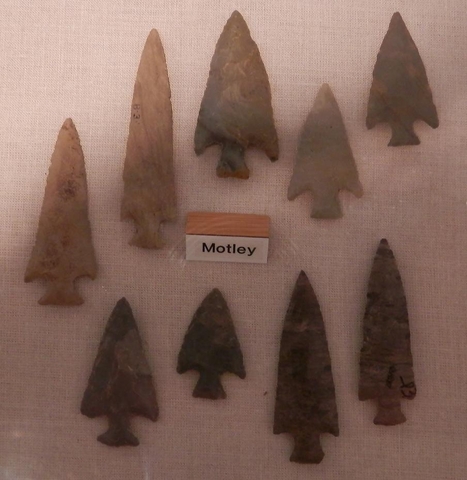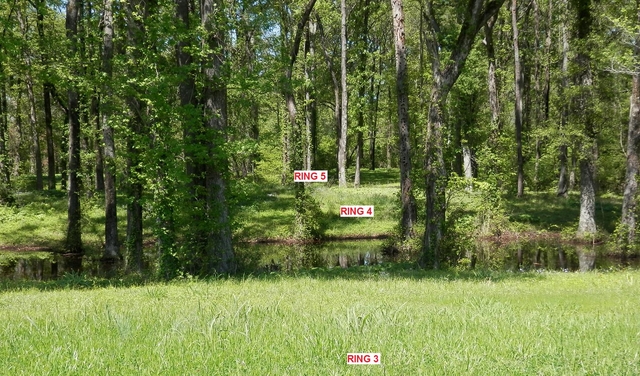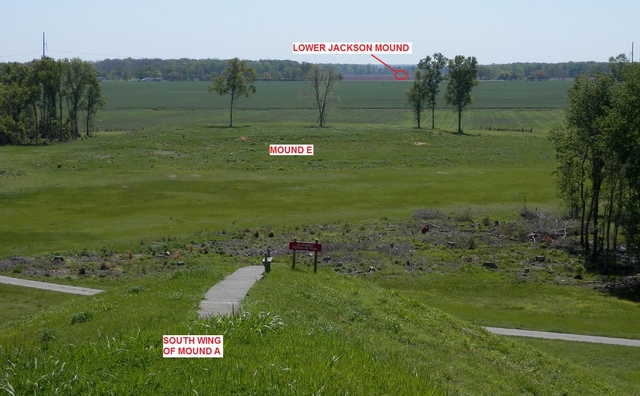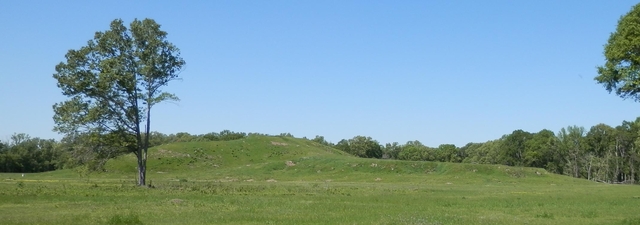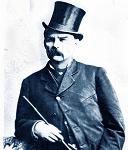
Bullethead
ELITE MEMBER-
Content count
2,578 -
Joined
-
Last visited
-
Days Won
2
Content Type
Profiles
Forums
Calendar
Gallery
Downloads
Store
Everything posted by Bullethead
-
From the album Poverty Point Trip
Regional Archaeologist Fran Hamilton starting work on a fallen tree's root ball. -
From the album Poverty Point Trip
Some of the best of many thounsans of excellent Motley points found at Poverty Point -
From the album Poverty Point Trip
The rings are best preserved on the north side, apparently due to little if any plowing over the years. Here, they're close to their original height. -
From the album Poverty Point Trip
Supposedly these 3 mounds and Mound B on the other side all line up. I'm not so sure Mound E fits the line and at present you can't see Mound B from Mound A. -
From the album Poverty Point Trip
Large circular structure of post holes found recently by remote sensing. -
From the album Poverty Point Trip
Biggest mound at site. Was largest man-made structure in Western Hemisphere when built. Still 2nd largest Indian mound. -

OFF2 DEVELOPMENT Screenshot - Fokker Dr.I needing to land soon...
Bullethead replied to Polovski's topic in WOFF UE/PE - General Discussion
You know I've been perfectly willing to preorder this since about 3 years ago.... Just another reason why :). -
I've never flown for a living so can't say. However, I do have some relevant experiences that I offer FWIW. Maybe you'll find them useful. I just turned 49 and have made a couple career changes during my 40s (and quite a few beforehand, too). From birth until about age 25, all I wanted to do for a living was fly. That never happened and I've never regretted it. That's because I've done a lot of other things, most of which I'd never considered doing until Fate pushed me into them. I've enjoyed most of them, at least for a while (which is about the best you can say for any job). First off, understand that while I've had at least 6 (probably more) career changes, I never wanted any of them. In fact, my advice to you is to avoid them like the plague. This is because the whole idea of a career means getting better (or at least more senior) at what you do, climbing the ladder, building up a nice retirement fund, etc. Any time you start doing a totally new job (as opposed to essentially the same job for a different company), you lose everything you've built up at your old job. Sure, you're a more well-rounded person for all that, but you have to start at the bottom again because you don't know any more about your new job than a new college graduate. And the older you get, the worse this gets, especially if you have a resume' with a lot of different previous employers in a lot of different industries. So unless you have no other choice, IMHO it's always better to stay where you are or at least in a related field. This is especially true for 40-somethings who have been in the same industry since they hit the market, so have accumulated the usual trappings of large house payment, kids needing college money, etc. Most folks our age at total wage slaves, chained to their current position by such obligations, financially precluded from changing careers voluntarily. Now, if you're lucky enough to be single, childless, and paying rent in your 40s, odds are you'll stay that way, so your only financial concern is having enough money to last your remaining life once you're too old to work. This increases your career options. But on the whole, career changes aren't pleasant for the pocketbook so should be avoided if at all possible. Now, if you HAVE to find another job in a new industry, I'd recommend doing something based on your primary needs. For most 40-somethings, that's supporting their family. You might not think you'll like what's available, but once you get into it, it probably won't be any more onerous than your previous job. And Hell, you might even find you like it. So my advice would be to find something where you can make from day 1 as close as possible to what you were making before. Only think about a really radical change if nothing else is available.
-
Is she giving autographs? How many poparazzi are camped out in your yard already? What's the daily bag limit on poparazzi, anyway? Good hunting
-
My main problem with the kill cam thing is that it's not smart enough to reposition the camera when there's a wall where the camera wants to go by default. In such cases, you get a weird, uncentered view, usually with some odd bit of you or your target in sight and at first think your view has gone haywire. I just started a new character who's basically a wizard in heavy armor, although he does use his sword fairly well when he runs out of magic juice. And believe it or not, I have found myself missing the kill cam, which at present doesn't exist for ranged attacks at all. Here's my new dude, Thorbald White-Eyes:
-
This morning about 0230, I got called out for a car on fire. At that time here, it was raining about as hard as physically possible. We got 4.25" of rain last night and I figure at least 3" fell during this incident. I literally couldn't see 15 feet without vehicle headlights and only about 30 feet with them. The car wasn't badly on fire (no surprise, given the rain). Where it was burning was all under the hood on teh driver's side. That whole headlight area was gone and the front driver's tire was burning. The other headlight was on. Anyway, we got the fire out pretty quick, pried open the hood (because the latch cable had burned away), and took the battery out. Given one headlight was totally incinerated and the other was on even though the switch was off and the key out of the car, I immediately suspected a headlight problem. We have a lot of car fires started by those HID headlights, especially where folks have retrofitted them to old cars like this one. But we soon discovered this car had regular halogens and burnt headlight couldn't have lit the tire on fire, so the fire had to have started lower. And the other headlight was on simply because a short occurred in the one that burned up. It turned out the fire started down low near the driver's front wheel steering area. Apparently oil had been leaking there for some time and eventually it got hot enough to ignite. The car had just arrived home a few minutes before we got called, and exhaust pipes actually get hotter for a while after you stop the engine. So the moral to the story is, if your car is leaking oil, get it fixed. Even a little leak can eventually result it in catching fire. And then I'll have to come out at 0230 in a monumental downpour and deal with it. I haven't quite dried out from that yet. Oh, and don't retrofit your old car with HID headlights, either :).
-

OT: I've Seen Fire and I've Seen Rain
Bullethead replied to Bullethead's topic in WOFF UE/PE - General Discussion
So which was it? Before or after? I have another fire safety tip I was reminded of yesterday: Any good done by scented or "armoma therapy" candles is usually outweighed by the smell of wet ashes coming from where your home used to be. It's amazing how many people think these candles have to live in nests and pile up colored gauze and dried leaves and flowers all around them. Or put them on top of a toilet tank or bathroom counter just below a towel rack. We get several fires a year started by such braindead things, the most recent yesterday. -

Reconnaissance Flight Patterns
Bullethead replied to Wayfarer's topic in WOFF UE/PE - General Discussion
As I understand things, most single-engined 2-seaters could carry a camera, or a wireless, but not both at once. So, I was thinking that on a recon mission, they'd probably have a camera, and any arty they saw along the way would be jotted down in pencil on a map. Anyway, as to how to fly the missions, I think that if you're over the trenches, you fly along them in long, straight lines. If you're not that far behind the front, you fly along roads in the general area of your objective. If you're way behind the lines, you'd fly over several separate, specific points (like railyards) and maybe circle each one a time or 2, depending on whether you had a camera or just a notebook. On the use of wireless, I think that was pretty much entirely for realtime adjustment of artillery fire. The reason this could be done with Morse was that it was in a standard, pre-arranged message format, which greatly reduced the amount of info needing transmission. Basically, to the receiver, it was just filling in the blanks on a message form without having to send the whole sentences. But this sort of thing doesn't work so well with spotting reports, which might cover any subject. As I understand things, using wireless also required the plane to fly in long, straight lines. This is because the extremely low frequencies used in that day required very long antennas. In most planes, this was a long piece of wire carried on a spool, which had to be reeled in and out. But then the airplane had to fly in a straight line to keep the wire straight behind it (or possible flew in a circle with its nose just behind the end of the wire). This is because radio waves come off perpendicular to the wire's axis, and if you've got a bend in the wire, it tends to screw things up on the inboard side. So a plane flying in a straight line would probably be parallel to the front, to talk back to the guns in the rear. OTOH, a plane chasing its tail could talk in any direction. I know this is sometimes used today but I've never heard of it from WW1. So, assuming WW1 planes flew straight while transmitting, I'd expect an artillery observer to fly racetrack patterns. Each straight leg would consist of observing the fall of shot and transmitting the adjustment, then making a U-turn in time to do so again for the next salvo, the object being to stay more or less in the same general area relative to the target, thus keeping the observer's line of sight more or less constant. -

Reconnaissance Flight Patterns
Bullethead replied to Wayfarer's topic in WOFF UE/PE - General Discussion
That was a good book. IIRC, the Long Recon was highly dreaded because so few came back, and they just kept on doing it. And the author was eventually forced down by flak on such a mission, wasn't he? The IAF did very similar things. It carried out its own recon between major raids to help with target selection. In their case, the job fell to the DH4 squadrons because its planes had much better performance and much more reliable engines than the DH9 squadrons. The IAF was usually limited to 1 raid every 3 to 5 days due to damage and engine maintenance after a major effort. During this downtime, they'd have a couple of DH4s available and the squadron and/or flight leaders would take them out on these long recon trips. They did these at about 20,000 feet and I don't think they ever lost a plane this way. -

Reconnaissance Flight Patterns
Bullethead replied to Wayfarer's topic in WOFF UE/PE - General Discussion
From what I understand (and I'm certainly no expert), I think a lot depended on what the airplane was looking for and what it was supposed to do if it saw anything. I'm assuming this is a pure recon mission with no intention to attack, which gives several possibilities. As I understand things, different recon missions with different objectives covered the tactical, operational, and strategic zones. Often, these recon missions would take photos, but generally only in the tactical zone was it necessary to fly in a straight line to get overlapping pictures. Also, there was a sort of overlap between pure recon and arty spotting (in the counterbattery form--finding enemy guns, not directing friendly guns). In the tactical zone, one of the main tasks was mapping the enemy trench system because it could change on a daily basis. This would usually involve creation of a photo-mosaic with long, straight legs along the front. In the process, if any enemy batteries were noticed, they'd be marked down, too. In the operational zone, I think the main objective would have been to spot emeny troop and supply movements. Most of this would have been on foot or in wagons, effectively standing still compared to the airplane. Thus, if the plane got to a point and didn't see anything, there was no purpose in waiting around there. So I think most times planes would sweep through an area, perhaps following key roads and checking junctions. In the process, they'd look for heavy artillery batteries, supply dumps, etc., and no doubt check activity at any enemy airfields along the way. In the strategic zone, planes were looking for major troop movements, perhaps hinting at a pre-assault build-up. Most of this was done by train. All these trains ended up in mashalling yards and there were usually several such feeding any sector of the front. What the planes were looking for was more boxcars on the sidings than usual and a quick glance was all that was needed for that. So one plane would often fly over several such railyards in a single sortie and, if the idea was to bomb them later, probably also look at suspected enemy airfields in the vicinity. If the bombing mission was to be at night, the daylight recon flight might also try to determine a route with landmarks to help the bombers find the target. -

OT: I've Seen Fire and I've Seen Rain
Bullethead replied to Bullethead's topic in WOFF UE/PE - General Discussion
Back out '04, when fuel prices 1st jumped up, I was doing some over-the-road truckdriving. On a typical trip across the US, I'd see 1 or 2 burning trucks every day, sometimes more. Sometimes you could be passing 1 and see the smoke from the next in the distance. The cause of all these fires was friction. If you put your payment book, fuel receipts, and insurance policy in the same compartment, they'll rub together and start a fire .. Fire investigation isn't a modern thing, at least in the US. In fact, we're under a legal obligation to investigate every fire. I suppose the state's interest is in catching arsonists, but our main interest is helping our employers (as in taxpayers). Insurance companies presume all fires are arson until an investigation shows otherwise, so won't pay the owner until they receive our report. As to the weather, this year we really haven't had a winter. We've only had 2 or 3 freezing nights, and even then it was just before dawn. Hell, it's already been over 80^F several times this month, which is about 1 month early for that. All the flowers are blooming early, the bees are already swarming, etc. Very strange, considering it's snowed 3 of the last 5 years, often multiple times (which is quite rare here). Anyway, this storm was riding a cold front so it was about 55^F during the big rain. Was that before or after you smacked her for not calling the fire department first? -

OFF skinning tutorial ?
Bullethead replied to rjw's topic in WOFF 1 2 3 / UE - Skinning / Modeling Help
Yup, skinning can be very tedious. However, that's only in creating your basic template. Once you've got that, you can slap a new coat of paint on it in no time. That's why you usually see a bunch of paintjobs for the same plane from the same person. I typically end up with about 50-70 layers per skin. 5 or 6 of these are just aids to me during the construction process and aren't seen in the final product. 10 or 12 are structural features (control surface joints, control surface edge shading, rib shading, control line openings, fake 3D louvers, etc.) that will be common to all paintjobs for this particular plane. The rest are the actual paintjob I'm making, complete with national and personal markings, etc. -
I was just reading the March 2012 issue of Popular Mechanics, which has a partial transcript of the cockpit voice recording from Air France 447, which crashed in the Atlantic in 2009. The full transcript apparently has been available in France since late last year but this is the 1st I'd heard of it. Anyway, the root cause of the crash was that one of the 2 copilots pulled the stick back all the way, stalled the plane, then kept the stick all the way back. Thus, the plane remained stalled and mushed all the way down from 38,000 feet into the ocean, belly-first. A contributing cause seems to have been the nature of the Airbus flight control system, in the way it handles problems, and the way pilots are trained and become habituated to using that system. The interesting thing to me is that, prior to the black boxes being recovered, folks had speculated that the loss of airspeed indicators due to icing had been the main cause. This did, in fact, happen, but the avionics thawed out long before the crash, but the crew didn't know how to get themselves out of the mess anyway. So if it ain't Boeing, I ain't going.
-

OFF skinning tutorial ?
Bullethead replied to rjw's topic in WOFF 1 2 3 / UE - Skinning / Modeling Help
In general, all layers should be raster. There are only a couple of occasions where you need to use vector layers (such as making text follow a curved line, usually for some personal markings). I never use any other the other types at all. -
I think Widowmaker can appreciate this pic. Here we see that Ofi Losa (black dog) has become Ofi Lusakbi (brown dog). She chased a deer way beyond visual and audible range out into the woods. Then apparently on the way back, she decided it was a nice day to dig to China. This is the height of the local monsoon season so the ground is completely soggy. She was gone about an hour. For some reason, this pic doesn't do justice to the amount of mud on this dog. To truly understand the mess, look at those lumps near her front foot. Those are her dogtags, each of which had about 1/2" of mud caked on both sides. She was pretty much that way all over. And she know's she's about to get the garden hose treatment and that I'm not at all happy with her. Good thing I put my fire boots on or my legs would have been as bad off as the dog. So, Widowmaker, do your collies behave like this?
-
Ofi Losa knows that proper dogs are seen as infrequently as possible and heard even less. She communicates almost entirely by body language, only barking when somebody strange arrives at the homestead. She mever whines or whimpers. On the whole, this is a good thing, but she refuses to call when she's treed some game, which limits her effectiveness on the hunt. She's great at running critters up trees, but until I'm close enough to hear her jumping and scratching at the tree, I might as well be alone once she disappears into the underbrush in a chase. But OTOH, finding her improves my own tracking skills. I suppose she interprets my commands by my own body language, plus my gestures and tone of voice. I think tone is the biggy because she reacts properly even when she can't see me. This is because I've gotten the same, correct response from her regardless of the spoken language I use. I've tried at least 11 Indo-European, 2 Semetic, 1 Muskogean language on her. So definitely, she was bred to live with people and understand their wishes. I figure she'd do just fine if she were dropped off anywhere in the world and adopted by whatever tribe lived there. But for all that linguistic skill, she can't shake her doggy ways of rolling in the remains of dead skunks or steaming piles of bear excrement, and thinking she can dig a hole big enough for her faster than some game animal can run through a pre-existing burrow. Even though she knows such habits greatly annoy me, as shown by her repentant posture in the pic above.
-

OT-"Ground Resonace" tears helicopter in half.
Bullethead replied to Hauksbee's topic in WOFF UE/PE - General Discussion
Helicopters are necessary evils, because sometimes you just need the things they can do. But I try hard to avoid ever needing those things. Helicopter accidents killed more of my friends in the service than enemy fire. -
I went to the little museum in the podunk town of Jackson, LA, which is about 10 miles E of where I live. It's even more off the beaten track than St. Francisville but has a better collection of arrowheads. I hadn't been there in a few years because of lingering bad blood over an ill-starred romance with a Jackson belle, and while I've been gone they've made some changes. One thing I noticed this time that I didn't remember from before was the busted prop shown below. Supposedly, this came off Lucky Lindy's Jenny. Hopefully, you all will be able to read the print shown in 1 of the pics. If not, let me know and I'll provide a transcript. The guy standing next to it in another pic is my aged father, who is now about 5'9" tall. The prop's lower end is only a few inches off the floor and his eyes are about even with the center, to give you an idea of its size. The remains of the wing in the last pic are from a 1936 Beech Staggerwing. Looks like the lower wing to me. Every bit ot structure is wood. The rib skeletons are plywood, even the ones with the curved areas to go around internal bracing wires. All this wood is held together by itty bitty nails, too. No glue that I could see.
-
Although HitR was billed as a mere optional expansion pack, the American stuff was actually the least of it. HitR should really be considered P3.5 because it made many important changes in numerous key areas of the game. IOW, HitR is the current product, not BHaH, and really isn't optional because subsequent OFF patches have been based on it. So if you don't have HitR, you're way behind the times. Now I understand why you keep mentioning issues that were solved long ago :). Anyway, nobody nows when OFF2/P4 will come out but HitR is available now. And until you get HitR, you won't be getting the most out of P3.
-
Well, how goes it so far? There are 2 main paths to follow when making a skin: 1. If your graphics editor can work on DDS files directly, then copy any existing skin to a new name, make whatever changes you want, save it, copy it to the appropriate folder, and then select the skin in the game. 2. If your graphics editor doesn't do DDS files, then you need to convert the DDS file to something like a BMP. Because BMPs don't really support multiple layers, you then need to open the BMP file in your graphics editor and save it as its native file type, so you can use all the editor's features. Once you've done that, save it as a BMP, convert it back to DDS, put it in the appropriate folder, and select it in the game. Note that the skin you copy from the game is basically good only to show you where the various parts of the airplane are on the overall graphic. You have to make your own template using the original skin as a guide. By template, I mean getting all the ribs, panel lines, openings for control cables, etc., set up. Once you've got that, it's a simple matter to apply a new paintjob to the template you've just made. This is why you often see multiple paintjobs for the same airplane type by the same skinner. 90% of the work in making a skin is creating your own template. Once you've got that, it's all easy. However, if you're only making a minor change to an existing skin (adding a personal symbol, applying winter cammo, etc.), then you don't have to go to all this trouble. Just draw your stuff on top of the existing skin.


